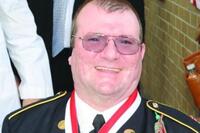Elizabeth Dole is a former U.S. senator from North Carolina and former Secretary of Labor and Transportation. She served as president of the American Red Cross and is founder of the Elizabeth Dole Foundation, which raises awareness and support for military caregivers.
Five-and-a-half-million military and veteran caregivers are dedicating their lives to caring for a veteran at home, usually without any formal training or understanding of the challenges that lie ahead. The Department of Veterans Affairs (VA) and veteran service providers are constantly introducing new resources, but these organizations struggle to connect caregivers with their services.
To empower these hidden heroes, it is critical to document the caregiver journey. That's why my Foundation, the VA and Philips just launched an interactive Military and Veteran Caregiver Journey Map to help convey the impact of caregiving on physical, psychological, financial and social well-being.
Two years in the making, the Caregiver Journey Map incorporates input from government agencies, non-profits, corporate partners, the faith community, and health care providers. But the most helpful contributions to the map have been from the families -- the spouses, mothers, dads, siblings and other loved ones tending to those who served our country.
Their stories have both broken my heart and greatly inspired me. Their experiences have brought into sharp focus the scenarios military caregivers face repeatedly. Among them:
Adjusting to the new role. When caring for a loved one, life changes. This process can be gradual or immediate. You might start by running a few extra errands or driving dad to his medical appointments. Then you sleep over a few nights at dad's house or reduce your job to part-time to be more available.
The military has a phrase for this: "mission creep." And it happens all the time to caregivers who may remain unaware of the resources available to them.
"I finally discovered that the VA has a great adult day care program," said Robert Grier, who cares for his Air Force veteran father in Pennsylvania. "That not only gave him a good social outlet, it also gave me some time to go to the gym."
On the other hand, you may be thrust into a caregiving role after a notification that your loved one has been injured.
Megan Smith, who cares for her husband, an Army officer who returned to service after losing a leg in an insider attack in Afghanistan, recalls a middle-of-the-night phone call that changed her world. She quickly made the decision to move her family from Florida to Maryland to support her husband's recovery at Walter Reed National Military Medical Center.
Navigating the health care system. Whether your loved one suffers from a wound, injury or illness, finding the right care can be confusing and frustrating. For military caregivers, seeking proper care often means navigating the Defense Department and the VA as well as civilian health care systems.
"We had 17 medical appointments in 10 business days," said Kathy Stalnaker, a caregiver to her retired Army sergeant husband. "Our VA hospital is almost two hours away. It's hard to get any work done at home because of this schedule."
For Kathy and so many other caregivers, the array of appointments and care coordination puts significant stress on work and family responsibilities.
Plugging into the Network. Many service organizations eager to extend assistance to military caregivers are frustrated because so many of these hidden heroes are unaware of available services. Caregivers are often left to find services on their own through endless hours of searching online.
"Our 'Pray for Kimmy' Facebook group has given me dialogue with thousands of caring friends, family, and concerned acquaintances," said Karee White, who tends to her Army veteran daughter in North Carolina. "We've received thoughtful and heartfelt direction and answers."
The Military and Veteran Caregiver Journey Map is a new, digital answer to a long-unanswered question: How do we best marry the needs of military caregivers to the parties that want to help?
The map seeks to connect the right resources to the right people at the right time. By mapping key points of interaction, the milestones where the appropriate people, organizations and service providers can step in, we'll achieve far better outcomes for our veterans and their caregivers.
These hidden heroes deserve our help, and they should not be left to chart their course alone.
-- The opinions expressed in this op-ed are those of the author and do not necessarily reflect the views of Military.com. If you would like to submit your own commentary, please send your article to opinions@military.com for consideration.















